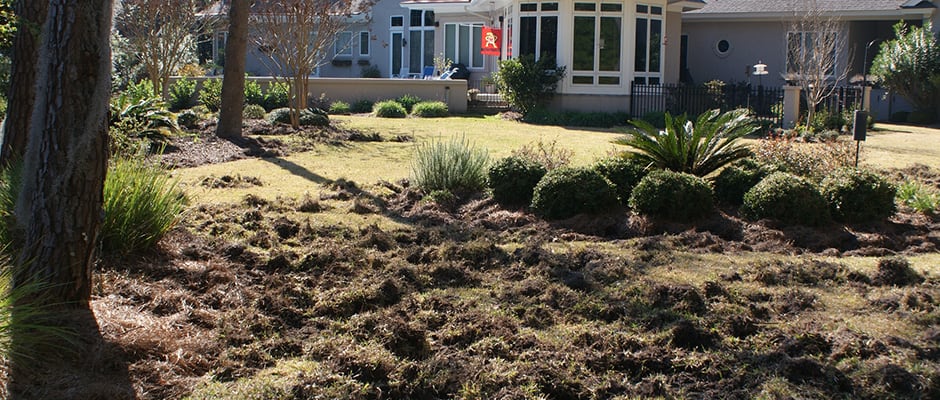Share this article
Collaborating to Halt Feral Swine Damage – from The Wildlife Professional Magazine
From the summer 2015 issue of The Wildlife Professional
Collaborating to Halt Feral Swine Damage
Early Efforts Showing Success
Unconstrained or unclaimed swine — which include Eurasian wild boars, Polynesian pigs, escaped and domestic swine as well as hybrids of these species — are often referred to as feral swine (Sus scrofa). Other names include wild pigs, feral pigs, wild boars or wild hogs, but regardless of the name, these animals are a harmful, destructive and invasive species.
Thirty years ago, feral swine only occurred in a small percentage of counties in 17 states (Timmons et al. 2012); however, today, they are present in at least 40 states and nearly half of all counties in the United States. Not only is the geographic range of feral swine expanding rapidly, their populations are growing (Barrios-Garcia and Ballari 2012). Humans likely worsened the problem by transporting the animals for hunting purposes. In addition, the lack of natural predators and their adaptability to nearly any environmental condition also have contributed to the growth of feral swine populations.
The Department of Agriculture’s Animal and Plant Health Inspection Service has developed a national response to reduce — and where possible, eliminate — the risks and damages inflicted by feral swine to agriculture, natural resources, property and human health. Here, we describe those risks and damages and how collaboration among federal, state, tribal and local entities is essential to curbing the spread of feral swine.
Damage to Agriculture
Estimates put the total aggregate cost associated with feral swine damage at $1.5 billion annually, with more than half due to direct agricultural damage (Pimentel 2007). No doubt, these costs will continue to rise as densities increase and populations expand even more. Of the estimated $800 million in annual crop losses (Pimentel 2007, Pimentel et al. 2005), much comes from feral swine consuming field and high-value vegetable crops (Schley and Roper 2003, Seward et al. 2004). Feral swine behaviors such as rooting, trampling and wallowing also destroy fields or render them far less productive. They also ravage tree seeds and seedlings, which impacts forest regeneration, retards the growth of larger trees and reduces nut crops such as pecans and almonds (Campbell and Long 2009).
Feral swine cause major damage to pasture grasses in addition to consuming, contaminating and destroying supplemental feed and mineral sources for livestock (Wigley 1995). Attacks on calves and lambs — and occasionally adult animals — also have been recorded. In Australia, where the estimated feral swine population is at least 20 million, predation on lambs is reported as high as 32 percent (Choquent et al. 1997). Ranch operators also suffer other losses including damage to fences, water sources, irrigation ditches and infrastructures. Furthermore, swine behaviors cause soil erosion, weakened levees and earthen dams, and increased siltation of ponds and other water bodies (Wirthner 2012).
Human, Animal Health Risks
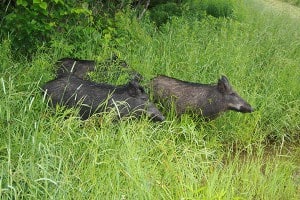
Feral swine roam freely. Some animals display mixed lineage traits of domestic hogs and Eurasian wild boars.
Image Credit: K. Van Wye, USDA Wildlife Services
Feral swine can carry up to 30 viral and bacterial diseases and nearly 40 parasites that can affect humans, domestic livestock and wildlife and that contribute to contamination of watersheds, soil and plants. A pilot study in Texas demonstrated that removing feral swine from a watershed reduced total E. coli contamination by almost 50 percent. Another pilot study revealed that 30 percent of feral swine samples tested positive for Leptospira, a bacterial disease that affects humans and animals. Feral swine also can transmit other zoonotic diseases to humans such as Brucella, an infectious disease caused by bacteria.
In urban and suburban areas, feral swine become less wary of humans over time and have aggressively approached golfers, picnickers and recreationists (Colorado State University 2012a). This type of encroachment likely increases as the animals learn to associate humans with food.
Property, Habitat and Wildlife Damage
Damage resulting from road collisions with feral swine is also common. In 2012, property damage and personal injury losses were estimated to be $36 million (Colorado State University 2012b).
However, estimates of damage to landscaping or recreational areas do not exist. Informal reports suggest efforts to improve properties often are ruined quickly if feral swine are in the vicinity. Destroyed vegetation and wallows not only reduce the aesthetic value of private properties but also public parks and recreational areas.
Feral swine both compete with and prey on native wildlife including threatened or endangered species (Fordham et al. 2006, Engeman et al. 2010). In Florida, feral swine are reported to have contributed to declines of at least 22 plant species and four species of amphibians listed as rare, threatened, endangered or of special concern. Predation and competition for food can negatively affect bobwhite quail, wild turkey and colonial nesting birds.
The animals consume three to five percent of their body weight daily, mostly herbaceous vegetation. Their eating habits have been linked to a 95 percent decline of understory vegetation (Cole et al. 2012) and subsequent declines in species that depend on understory vegetation, from arthropods to mammals (Singer et al. 1984).
Cooperative Efforts Paying Off
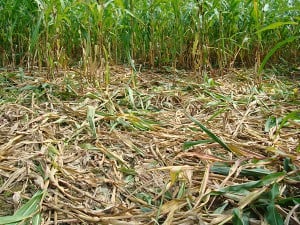
Feral swine damage to an Ohio corn field. In just one night, four hogs did significant damage to this field.
Including agricultural impacts, feral swine cause at least $1.5 billion in damage every year.
ImageCredit: C. Hicks, USDA Wildlife Services
In response to the mounting feral swine concerns, APHIS launched the Feral Swine Damage Management Program early last year. The agency is currently refining management approaches and strategies as it works through the National Environmental Policy Act process; however, current operations have already achieved some successes.
The state of Illinois also has achieved early success in working toward elimination of feral swine through a strong cooperative effort by Wildlife Services and the Illinois Department of Natural Resources. The Illinois Collaborative Feral Swine Damage Management Task Force was created with the goal of eliminating self-sustaining and reproducing populations of feral swine, protecting wildlife and habitat and ensuring early detection and removal of emerging populations. By fall 2014, the collaborative program had successfully removed 95 percent of feral swine in the southern part of the state as well as one population in central Illinois. Aerial and ground surveillance to remove the last remaining animals from these breeding populations will continue through 2015.
An intensive outreach campaign directed toward the public, agencies and organizations contributed to this accomplishment. Messaging in the campaign included the negative impacts of invasive feral swine and a means to report sightings and damage.
Collaborative agency efforts also helped pass new legislation making transport, possession and hunting of feral swine illegal. Hunters can now legally take feral swine only during the firearm deer seasons and when in possession of a valid permit to harvest a deer. Landowners can obtain a nuisance animal removal permit to protect their property.
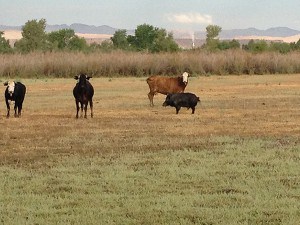
Feral swine graze with cattle. These destructive animals represent both a disease and predation threat to livestock and natural resources. In addition, natural swine behaviors such as wallowing in riparian areas can devastate the habitat of native species, including endangered species.
Image Credit: USDA Wildlife Services
Several years ago, government units and others in Kansas also recognized the need for managing invasive feral swine specifically to protect agricultural resources. Created in 2006, The Kansas Feral Swine Working Group was established to eliminate feral swine from the state and to reduce damage using control measures. The state also made sport hunting of feral swine illegal to limit the transport into and dispersal of the animals in the state.
To date, this cooperative, integrated management approach has eliminated 10 distinct populations of feral swine, some of which were small and localized as well as others that encompassed entire counties. At present, only one population remains in the interior of Kansas, but feral swine continue to be a problem along the state’s borders with Oklahoma and Missouri.
Wildlife Services is currently working with these neighboring states to stop this encroachment. The integrated approach includes outreach, public relations and management operations such as aerial or ground shooting and trapping. These efforts, which are being conducted almost entirely on private lands, require continued communication with landowners for property access. In the last eight years, Wildlife Services has obtained permission to work on more than 1 million acres throughout the state.
Further Collaborations
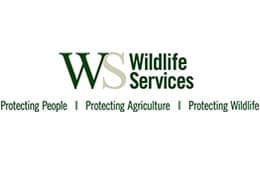 Recently, Wildlife Services received federal funds under a pilot project to combat feral swine in New Mexico. With excellent cost-share and in-kind collaborative support from the New Mexico Feral Swine Eradication Team, the program initiated in 2013 is on track to achieve the ambitious goal of feral swine elimination by 2018. So far, the program has cleared 10 of 17 counties of feral swine and worked to protect the federally threatened lesser prairie-chicken (Tympanuchus pallidicinctus) and dunes sagebrush lizard (Sceloporus arenicolus) and their habitats.
Recently, Wildlife Services received federal funds under a pilot project to combat feral swine in New Mexico. With excellent cost-share and in-kind collaborative support from the New Mexico Feral Swine Eradication Team, the program initiated in 2013 is on track to achieve the ambitious goal of feral swine elimination by 2018. So far, the program has cleared 10 of 17 counties of feral swine and worked to protect the federally threatened lesser prairie-chicken (Tympanuchus pallidicinctus) and dunes sagebrush lizard (Sceloporus arenicolus) and their habitats.
The Missouri Feral Hog Task Force represents numerous stakeholders, many of which provide funds or in-kind support. The goals include: eliminating feral swine in five target areas; reducing then eliminating feral swine populations to protect listed plants and insects; monitoring and testing for disease threats; and preventing establishment of feral swine populations in new areas. The Wildlife Services program provides assistance through outreach and educational activities such as conducting public meetings and forming local cooperatives with key interagency personnel. Outreach to landowners and land managers in feral swine target areas has facilitated permission to work on more than 850,000 acres and led to collaborative partnerships that have helped eliminate two of five identified feral swine populations.
In South Carolina, feral swine populations are large and widely distributed. The South Carolina Wild Hog Task Force’s Memorandum of Understanding coordinates efforts that encompass four major goals: providing awareness, education, and outreach opportunities; identifying problems, solutions, and research needs; determining short- and long-term management strategies; and supporting legislative actions to reduce negative impacts. Today, projects are underway to eliminate feral swine from a barrier island inhabited by Loggerhead sea turtles (Caretta caretta) and other threatened or endangered species. Wildlife Services continues to form cooperative relationships with landowners, which increases the acreage accessible for management efforts.
| Collaborative Efforts Finding Success
Among others, the five states listed here have made significant progress in reducing feral swine damage. Each has a strong coalition of stakeholders and a steering committee.
Broad Efforts Environmental conditions and laws governing feral swine vary considerably among states. As a result, APHIS also provides resources and expertise at a national level, while allowing states flexibility to manage operational activities from a local or state perspective. The program’s overall objective is to minimize damage inflicted by feral swine. In states where feral swine are emerging or populations are small, APHIS will continue to cooperate with local and state agencies to implement strategies to eliminate this invasive animal. |
Author Bios
 Wendy S. Anderson, CWB®, is the assistant program manager for the APHIS National Feral Swine Damage Management Program, USDA, APHIS Wildlife Services, Fort Collins, Colo.
Wendy S. Anderson, CWB®, is the assistant program manager for the APHIS National Feral Swine Damage Management Program, USDA, APHIS Wildlife Services, Fort Collins, Colo.
 Dale L. Nolte, PhD, is the program manager for the APHIS National Feral Swine Damage Management Program, USDA, APHIS Wildlife Services, Fort Collins, Colo.
Dale L. Nolte, PhD, is the program manager for the APHIS National Feral Swine Damage Management Program, USDA, APHIS Wildlife Services, Fort Collins, Colo.
Header Image:
Property damage caused by feral swine. Damage in suburban residential and recreational areas has become more common with the expanding range of feral swine.
Image Credit: USDA Wildlife Services



